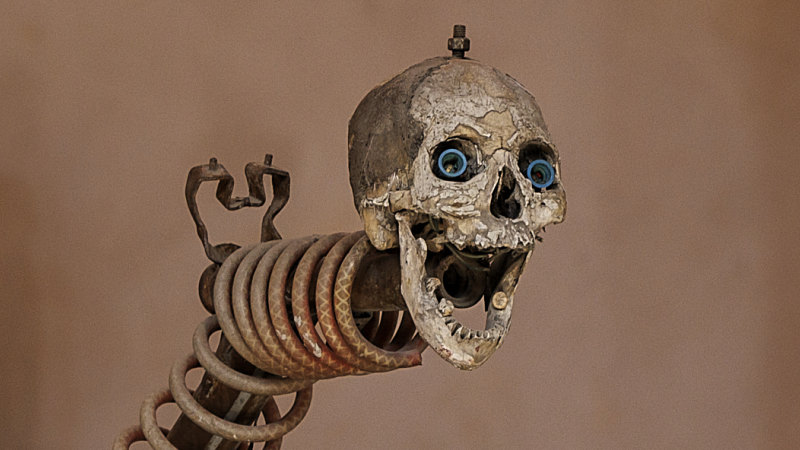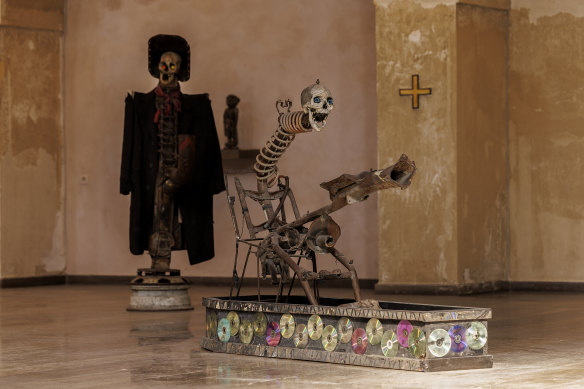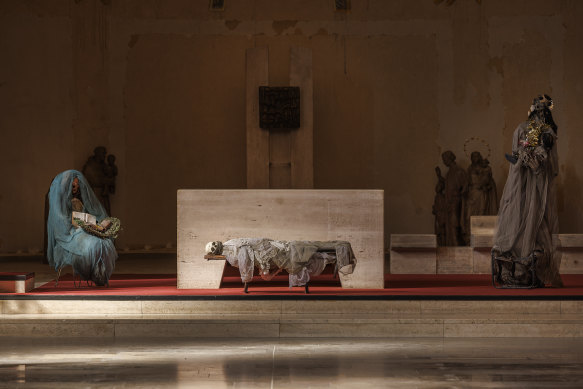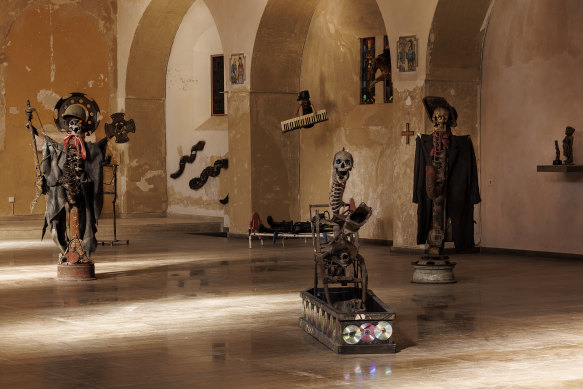By John Bailey
Credit:Frank Sperling
Save articles for later
Add articles to your saved list and come back to them any time.
For 12 days next month, a Christian chapter house in the heart of Melbourne will be transformed into a celebration of Haitian Vodou during our mid-winter RISING festival. Visitors to the lofty hall beside St Paul’s Cathedral will find a series of macabre-looking contraptions built from discarded metal, clothing and bones, including the remains of a man who never travelled abroad in his life but whose posthumous tour has taken in Boston, New York, Germany, and now Melbourne.
Ghetto Biennale, described as “a celebration of Haitian street culture”, is the work of art collective Atis Rezistans, which was co-founded by artist Andre Eugene in 2009. Eugene was among a handful of Haitian artists who were denied entry to the US after being invited to take part in a group exhibition in Miami. In response, they established their own biennale, inviting local and international talents to collaborate in an environment that’s very different to the great halls and ultra-modern galleries of the contemporary art world.
“We invited many people from all over the world but don’t forget that where we live is a ghetto,” Eugene tells me during a precarious early morning phone call. Power blackouts mean that he’s sitting in darkness, with both lighting and internet out of action. “I’ve got a yard, I work in the yard with people and these are poor people, not academic artists. They’re like autodidacts,” he says.
A documentary on Atis Rezistans paints a compelling image of the corner of Port-au-Prince that these artists call home. It’s a sea of corrugated iron and cinder blocks, exposed reinforcing and stripped-down vehicles. The raw materials they employ in their work is reflective of this world – sculptures assembled from car parts, building materials, roadside litter – and bones.
“The recycled material is really important for me because where I live you can find many trash all over, everywhere,” says Eugene. “The mayor is never cleaning the street. And sometimes when the police descend on the protests in the street they put fire in the tyres, and smoke in the air is not good for your health. That’s the reason I recycle everything.”
At the various events in which Ghetto Biennale has appeared around the world, it’s the human bones – a symbol of the interconnectedness of the living and the dead in the Vodou religion – that attract the most attention. In Haiti bones are common in Vodou altars and sculptures, but Eugene’s Biennale co-curator, Leah Gordon, says people do slightly obsess over the body parts.
“We were aware in Germany that we had to explain it, and we had a notice up at the installation that explained the relationship between body parts and Vodou. The irony was that people were a bit shocked in Germany but the church we were in was Catholic and it had body parts of saints in the church.”
The Ghetto Biennale installation in Kassell, Germany, in June 2022.Credit:Frank Sperling
When Ghetto Biennale travels it does tend to present in Christian spaces. It’s suggestive of the complex links between Vodou and the religions of Haiti’s former colonisers.
“Catholicism was used as a kind of excuse for the slave trade,” says Gordon. “They were capturing souls, so a lot of Haitians carried on practising Vodou but would hide it under symbolism of Catholic saints.”
The snake spirit Damballa, for instance, would be represented through the figure of St Patrick, who was usually depicted ridding Ireland of snakes. Papa Legba, the spirit who opens the portal between the spirit realm and the earthly world, could be invoked through the image of St Peter at the pearly gates.
Bones are common in Vodou altars and sculptures, and a central element of Ghetto Biennale.Credit:Frank Sperling
The works in Ghetto Biennale might be informed by spiritual traditions, but they’re also reflective of centuries of history and politics. Vodou was central to the Haitian Revolution. Slaves performed ceremonies before setting their fields aflame and going into battle.
Outsiders often arrive with a Hollywood notion of Vodou. “[They] come into my yard and say that Vodou is the devil,” says Eugene. “People don’t remember that if we don’t have the Vodou religion we don’t have freedom.”
Says Gordon: “It’s very important that the installation relates to Haitian history as well as Haitian spirits, and showing how the two are interbound.” Several of Eugene’s sculptures appearing in RISING represent the spirits known as Gede. “Gede is a Vodou spirit that this neighbourhood is very into. It’s a spirit that has really taken the imagination of the urban poor, a spirit of death and sex bound together,” says Gordon. That explains the grinning skulls and giant phalluses fashioned from junkyard detritus.
“It’s not so much macho as kind of laughing at death and looking at how sex and reproduction overcomes death, rather than some kind of ‘look what a big dick we have’.”
The close proximity of rebellious eroticism and all-too-real reminders of mortality, delivered via the make-do aesthetic of trash and cast-offs, all fuse together – literally – to give voice to spirits living and otherwise.
Take that anonymous man whose bones are now part of a work that arose from a visa knockback nearly 15 years ago. As Eugene often jokes, it’s ironic that the guy’s died and suddenly doesn’t need a visa.
Ghetto Biennale is at Alpha60 Chapter House, Level 2/195 Flinders Lane, June 7-18 (closed Mondays and Tuesdays), free.
Find out the next TV, streaming series and movies to add to your must-sees. Get The Watchlist delivered every Thursday.
Most Viewed in Culture
Source: Read Full Article




